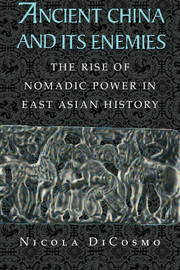Book contents
- Frontmatter
- Contents
- Acknowledgments
- Introduction
- Part I
- Part II
- 3 Beasts and Birds: The Historical Context of Early Chinese Perceptions of the Northern Peoples
- 4 Walls and Horses: The Beginning of Historical Contacts between Horse-Riding Nomads and Chinese States
- Part III
- Part IV
- Conclusion
- Glossary
- Select Bibliography
- Index
4 - Walls and Horses: The Beginning of Historical Contacts between Horse-Riding Nomads and Chinese States
Published online by Cambridge University Press: 25 August 2009
- Frontmatter
- Contents
- Acknowledgments
- Introduction
- Part I
- Part II
- 3 Beasts and Birds: The Historical Context of Early Chinese Perceptions of the Northern Peoples
- 4 Walls and Horses: The Beginning of Historical Contacts between Horse-Riding Nomads and Chinese States
- Part III
- Part IV
- Conclusion
- Glossary
- Select Bibliography
- Index
Summary
Introduction
No other period in pre-imperial history transformed the physical aspect and the political import of the northern frontier as much as the Warring States period (480–221 b.c.). In China, the growth of state power and the increase in the size of its armies required a constant expansion of the resources of the state, forcing each ruler to find ways to maximize his own resources and try to neutralize his adversaries' advantages. During the late Warring States period, the tendency toward territorial expansion continued steadily, with the three northern states of Ch'in, Yen, and Chao trying to extend their control over new lands and peoples. The northern frontier was made part of this process of state aggrandizement, but in contrast with the earlier centuries, the Central States were now confronted with a new and far more difficult situation.
As outlined in Chapter 3, the development of pastoral cultures in northern China brought into existence martial societies of aristocratic mounted nomads. As a new “anthropological” type, the nomads appear in Chinese sources under the name of Hu. Their lifestyle was nomadic: they raised animals, fought on horseback, and excelled at archery. Probably organized into hierarchical kin-based societies divided into lineages and tribes, the Hu would soon prove capable of creating empirelike political units. Were they new to northern China? In the fifth and fourth centuries b.c., certainly not, but our knowledge is based solely on archaeological material, and an absolute chronology is still not available.
- Type
- Chapter
- Information
- Ancient China and its EnemiesThe Rise of Nomadic Power in East Asian History, pp. 127 - 158Publisher: Cambridge University PressPrint publication year: 2002



